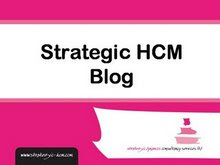
People always seem to have lots of energy and enthusiasm for the community leading up to and following on from these events, but we find it hard to maintain much, even just in the way of conversation, between the events – at least on the community site (connectinghr.org).
Yes, there’s quite a lot of chat which continues on twitter (some using the hashtag #connectinghr) but I think partly because of the 140 character limitation, and also because the chat gets mixed up with so many other things, this can only go so far in supporting the community.
We’re trying different ways of generating more ongoing support for the community, for example we’ve recently established a council of ‘elders’, or ‘lowerarchy’ (vs hierarchy) but even here, we’ve struggled to get much input from our community elders.
Please don’t misinterpret these comments – I’m definitely not complaining about a lack of input. Everyone is increasingly busy these days, with any number of priorities, and increasingly a growing number of community roles too. We also suffer in that ConnectingHR is a inter-organisational community, so it doesn’t have the focus and context that an intra-organisational community has. It also doesn’t have a formal purpose – it’s only real objective is to be a community. (I don’t think there’s anything wrong with this – being part of a community does provide benefits in its own right, and should lead to the development of further, outcome focused sub-objectives, like the current mentoring programme, or CSR focus, as the community develops. But it also definitely makes it harder to maintain interest.)
But many of these challenges are shared by intra-organisational communities too. This is why I think ConnectingHR is so important – if community management is the new HR, then HR professionals need to gain experience in participating in and leading communities. And there are some big questions associated with communities which I don’t think have been firmly answered yet. An example is the including of community participation in performance management.
What we do know is that community participation is a discretionary activity, based upon intrinsic motivation to participate, and that therefore it can’t be directed in the same way as participation in projects and in undertaking day-to-day tasks.
However, as communities become more important, and an increasingly important aspect of many peoples’ jobs, I think they’re also too significant to leave out of performance management. The key for me in doing this is understanding that no-one is ever going to be able to contribute to all communities in the same way.
We know from Jakob Nielson’s (90-9-1) theory of Participation Inequality (or Jake McKee’s variant) that in social groups, some people actively participate more than others. In fact, in most online communities, 90% of users are lurkers who never contribute, 9% contribute a little, and 1% of users account for almost all of the action. So, for example:
- 167,113 of Amazon’s book reviews were contributed by just a few “top-100″ reviewers.
- Over 50% of all the Wikipedia edits are done by just .7% of the users … 524 people.
- In December 20, 2007 on the MSDN Community site, 1866 edits out of 10851 total edits were made by the top five contributors (three of whom are Microsoft employees). That percentage is slightly above one percent at 1.72%.
- Just 0.16% of all visitors to YouTube upload videos to it, and 0.2% of visitors to Flickr upload photos.
Now it used, maybe, to be the case that people retained these roles from community to community, but I think as more people climb the social technographic ladder (or Altimeter’s Socialgraphic pyramid, Brian Solis’ behaviourgraphics etc), this is starting to change.
The new corollary of the 90-9-1 theory, is, I believe, my theory of Individual Divided Participation (as I’ve never seen anyone else propose this before). In this theory, most people can only manage to contribute extensively to 1 (or 2 or 3) communities, maybe support another 9, and to take a back-seat role (to lurk) in another 90.
Performance management needs to reflect these different expectations. So a line manager might expect a report to be able to identify a couple of communities that they are actively involved in, as curators and creators. Hard objectives shouldn’t be mandated for these roles, but a manager and report should be able to discuss the broad approach that the employee is going to take to their communities (which ones they are going to invest in, and in what sort of ways). Their performance can they be reviewed, loosly, against these expectations, or against defined behaviours (or competencies).
They may also be able to identify a handful of other communities which they involve themselves in, but not to anything like the extent of the above. And they shouldn’t be expected to do anything other than lurk in the other 90.
Community oriented performance management should also focus on improving someone’s community involvement, ie for development, than for assessment – initially at least.
As for ConnectingHR, the challenge for us, it to find ways that will mean people will attach more importance to this community, so that more people put it as their top, or in their top 2 or 3, community/ies. Not easy to do, but we’re not going to give up. And in the meantime, I look forward to another highly engaging tweet-up tomorrow night!
- Consulting - Research - Speaking - Training - Writing
- Strategy - Team development - Web 2.0 - Change
- Contact me to create more value for your business
- jon [dot] ingham [at] social [dash] advantage [dot] com
.



















No comments:
Post a Comment
Please add your comment here (email me your comments if you have trouble and I'll put them up for you)